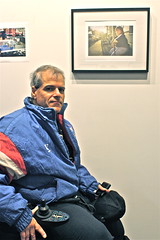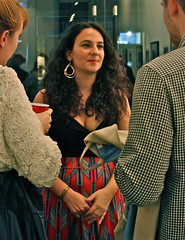John Aliseo’s photograph is stark and haunting: a woman with a lined, worried face stares past the camera, her back to the setting sun. On Wednesday, it was perhaps the most popular photograph at the opening of an exhibition at the Mark Miller Gallery on Orchard Street. “Our Eyes, Our Lives” premieres the work of residents at Barrier Free Living, a shelter on East Second Street that specializes in serving individuals with disabilities and victims of domestic abuse.
The exhibition was the brainchild of photojournalist Emily Anne Epstein, 26, a staff photographer at Metro newspaper whose grandparents hail from the Lower East Side. She first visited Barrier Free Living last year as part of a work assignment documenting the affects of budget cuts on shelters across the city. After she photographed the shelter’s residents, they asked her so many questions about her camera, she decided to return in May to teach them.
With the help of Kate Engelbrecht of The Girl Project (an organization that donates cameras to teenage girls as a source of empowerment), Ms. Epstein obtained hundreds of disposable cameras and distributed them to the class’s students – between 20 and 30 residents a week. Her lessons balanced technical instruction with in-the-field training. The students’ only assignment was to go out into their neighborhood and take pictures of what was important to them.
“Photography is a democratic art,” Ms. Epstein said. “It’s not about the camera. It’s what you’re looking at, not what you’re holding.”
Mr. Aliseo, 52, took his photo on the steps of Barrier Free Living in May. The woman with the careworn face is Phyllis, another resident.
“Phyllis is still at the shelter,” Mr. Aliseo said. “[The photo] really did capture her expression inside – waiting. I think it was a good indication of what she was doing: waiting for housing.”
Mr. Aliseo, a native New Yorker, is confined to an electronic wheelchair due to a form of muscular dystrophy, but he maintains a cheerful smile. He was a longtime employee of Con Edison before following his wife to Virginia. Mr. Alieo said that after a psychologically abusive relationship, he was abandoned by his spouse and forced to move back to New York.
“When I came back to the city I had no one I could go to,” he said. The Department of Housing Services helped him find Barrier Free Living, where he lived for close to a year. He recently transitioned out of the shelter and into permanent housing in Staten Island.
“A lot of people [at Barrier Free Living] were going through a lot worse than I was,” Mr. Aliseo said. “I heard horrific stories.” He remembers one young man in particular who was paralyzed after being thrown to the ground by a guardian.
Barrier Free Living was founded thirty years ago by social worker Paul Feuerstein. Its two residential shelters, one in the East Village and one at a confidential location in East Harlem, are open year-round. In addition, an active outreach team hits the streets to bring direct assistance to the community’s homeless. Services include nursing care, psychological counseling, and occupational therapy. Soon the agency hopes to expand into the South Bronx.
The East Village shelter houses 48 single adults from all five boroughs as well as other states. The demand always outstrips resources, said Donald Logan, the organization’s chief operating officer. “We know if we had 148 beds, we would not have one empty one,” he said. “There are very few shelters, if any, that are equipped to handle people with disabilities. The majority of people here use wheelchairs, or Seeing Eye dogs, or are deaf. We have diabetics, people on dialysis who require more care than other New York shelters are able to provide. Right now, we’re it.”
Classes like Ms. Epstein’s serve as more than just a source of distraction, said Scott Hess, the shelter’s organizational development manager. “It’s a therapeutic tool – an empowerment tool,” he said.
It was also a source of catharsis, according to Ms. Epstein. “Critiques would turn into people sharing their own personal stories,” she said. One client brought in a picture that showed a man sitting on a couch. “The resident told us, ‘this photo represents my ex-husband,’ and then proceeded to tell us what he would do. To have that outlet is important.”
At the Mark Miller Gallery, Mr. Aliseo’s photograph was the first of the evening to sell. “This was a nice surprise,” he said. “It feels good to be recognized.” All the proceeds from the exhibition will go directly to the agency. “It was beyond our wildest dreams that [Ms. Epstein] would even do a show,” Mr. Hess said. “It was a great success. We definitely want to replicate it.”





